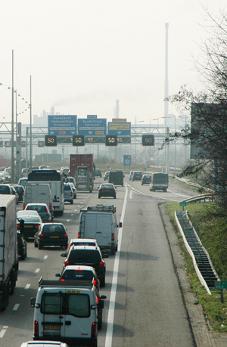Transumo A15 project: Vision creation and vision
| Function / Domain: | Transport and spatial planning |
| Illustration of: | Vision creation, Guiding principles, Target scenarios/packages of measures |
Context and landscape developments
Dutch public authorities are struggling with problems relating to mobility, air quality, energy consumption and CO emissions. The Mainport Rotterdam is affected by all of these problems. The Mainport is of great importance for both the regional and national economy. But the A15 motorway - a symbol of the connections between the port and the hinterland - is already often jammed. With the planned construction of the Second Maasvlakte port and industrial area, traffic to and from the port will increase by a factor of three, with all of the ensuing consequences for mobility in the region and for air quality, noise and external security. The space in the neighbouring residential areas will also become scarcer, since new houses and business premises will have to be built further from the road. The problems associated with the A-15 therefore encompass the domains of People, Planet and Profit.
Exploratory study
A working group with representatives of the participating organisations, advised by a steering committee, therefore launched the Transumo A-15 project, Van Maasvlakte naar achterland. More than 250 parties were involved in this project, the aim of which was to explore new possibilities for making sustainable improvements in the connections between the port of Rotterdam and the hinterland. The primary objective was to reach a shared perception of the problems and to increase the sense of urgency of the need for an innovative approach. Less attention was devoted to collective vision creation.
Leading partners in the project were Erasmus University in Rotterdam, Rotterdam Port Management, Deltalinqa, the city of Rotterdam, the Rotterdam Urban Region, TNO, the Rijnmond environmental department and Transumo, a network organisation for sustainable mobility.
Exploratory interviews and workshops
The A-15 project started with exploratory interviews with stakeholders to discuss their long-term vision for sustainable transport in the region (what they would personally like to see), important trends, problems and possible solutions.
In the following workshops, the stakeholders discussed their wishes and explored the possibility of reaching consensus on their perception of the problems and a shared sense of urgency. They also discussed actual measures that could be taken.
The project team supplemented the information with desk research and analyses and the opinions of experts.
Impulse for innovation
The participants were chosen on the basis of the parties they represented rather than for their creative capacity. This is probably why the project team felt the initial results were not particularly innovative and did not go far enough in the view of the project team. It therefore decided to stimulate innovative ideas by organising two workshops with outsiders. The participants were selected for their refreshing outlook and creative ideas. They came up with ideas for improving the project as well as the process.
These workshops resulted in a widely shared view that in time the existing ideas (included in implementation and policy plans such as Randstad Urgent and the Maasvlakte 2 Monitoring and Evaluation Programme (MER-MV2)) would not be enough and that more far-reaching measures would be needed.
Guiding principles for further elaboration
The guiding principles for taking the next step towards an implementing programme were:
- Sustainable mobility would be defined in terms of traffic effects, air quality, noise and external security.
- The legal standards for those aspects were a minimum; targets that went beyond the legal standards would also be used, in accordance with the stakeholders' desired scenarios.
- The points of departure for the measures proposed in the Environmental Impact Assessment would be followed.
- Uncertainties would be discounted in the detailed plans. See the example, Transumo A-15 project: Working with uncertainty.
Transition paths
The principles initially led to a 3D package of measures that appealed to the stakeholders. Its effectiveness in various situations was then calculated. The project also produced a list of cultural and organisational lock-ins that could frustrate the transition to sustainable transport in the mainport area. The results were discussed with the participants and promising measures were worked out in more detail. They were incorporated in three transition paths:
- Sustainable traffic and mobility management
- Container logistics, modal split and more sustainable transport
- Space, economy and reducing transport.
Leverage
The final step in the process of reorientation/vision creation involved the formulation of 11 ‘levers' that could initiate or accelerate the transition to sustainable transport. Two examples of these levers are given below.
Learning to keep ahead of major change processes This aspect of the project involved using the example of the transition to a bio-based economy to learn more about how to anticipate economic and spatial developments in steering a project: how to plan for reduced transport, the creation of clusters and increased sustainability. This fosters an integrated approach to the use of space and transport and so prevents the bio-based economy from actually generating new transport movements.
From modal split to intermodal steering This lever is intended to transform the strategy of shifting the modal split from road to water into a strategy for intermodal steering. Special attention is devoted to the governance arrangements at terminals and transferia, the use of information technology and new logistics concepts (push & pull, hub & spoke, flow, co-siting). The idea is that stakeholders (forwarders, for example) should be confronted with an integrated cost price for their activities.
Realisation
For the practical implementation of the proposals talks were held with the main stakeholders in the region. In 2010 the expectation was that the Transport Enterprise established by the Ministry of Transport, Public Works and Water Management, the municipality of Rotterdam and the Rotterdam Port Management would play a role in this.
Sources
- http://www.transumofootprint.nl/ english section, project A15
